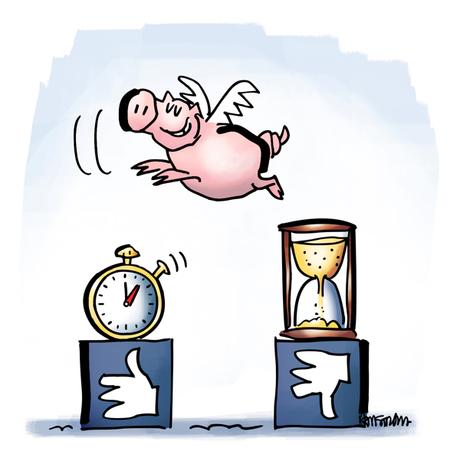
 A headline in the Wall Street Journal caught my eye: Detecting Fake News Takes Time.
A headline in the Wall Street Journal caught my eye: Detecting Fake News Takes Time.
Alison Gopnik wrote about a psychology experiment in which participants were asked to decide whether a series of social media headlines were true or false.

They also had to fill out a questionnaire about their political beliefs.

Results: sure enough, people were more apt to believe fake news that fit their political beliefs.

But regardless of those beliefs, they did better at spotting fake news when they had time to think about it.
Is there a message here for brands?

Nowadays, everyone talks about “authenticity.” Brands need to be authentic, or customers will desert them.

Here’s the plain English version: you have to do what you say. If you don’t keep your promises, word gets around.

You can trick someone into believing a pig can fly, but when he’s had time to think about it, he’ll dismiss the pig as fake news.

Brands launch pigs all the time. Clickbait headlines are a good example.

You click the link and get a sales pitch or rehashed content you’ve read a thousand times before. Nothing fraudulent or perverse, just “curses, fooled again.”

Why do brands do this? To get attention.

I can sympathize: if you don’t get people’s attention, no one’s going to read your content.

“Authenticity” is often equated with “purpose.” As in: a brand must be true to its “purpose.”

Brands seem to redefine their purpose in response to current events.

Too often brand purpose becomes flavor-of-the-month political correctness.

“We’re here for you during the pandemic.”

You heard that a few million times, right?

Right now many brands are donating to “Black Lives Matter.”

Black Lives Matter (the organization, not the slogan) supports defunding the police and “disrupting” the nuclear family. As part of the Movement for Black Lives (M4BL), BLM also supports “reparations for past and continuing harms,” and abolishing capitalism.
Do brands really support these same goals?– or are they afraid of being denounced as racially insensitive if they don’t donate?

(CNET published a list of donating brands, and prefaced it with this line: “CNET encourages you to spend some time researching the companies you buy from to ensure they align with your values and ethics.”)

Jumping on bandwagons is just another flying pig. Strictly short-term. It gets you the “right” attention, and/or keeps you out of someone’s crosshairs.

It’s also “keeping up with the Joneses,” and doing what everyone else is doing.

Which is really short-term thinking because it means you blend in when brands need to stand out.
A better strategy: have a great product or service. Provide great customer service. Be an expert. Figure out a way to be different. Treat all your employees and customers with the same respect and courtesy.
Oh– my pet parrot just said to add: be human.

